How to Draw a Amazon River Dolphin TUTORIAL
| Amazon river dolphin |
|---|
 |
| Scientific Classification |
|
| Binomial Name |
| Inia geoffrensis |
| Subspecies |
|
| Boto lives in Amazon river. |
| |
The Amazon river dolphin is the largest and the most well known species of river dolphin. It is known by the scientific name Inia geoffrensis and has three subspecies. It has long nib and streamlined trunk to adapt to the environments. It lacks hairs on the body like other dolphins, simply it has melon for echolocation and is able to move its neck about 180 degrees. The most dominant characteristic is its body colour. It depends on each dolphin, but usually it is tinged with pink and sometimes bluish gray or off-white. Uniquely, the male and the female dolphin segregate from each other and come out to the main river to run across during the mating flavor. For habitat, it can live any fresh water and the dominantly observed at the Amazon and Orinoco watersheds. Information technology lives on crustaceans, crabs, turtles, and 50 kinds of fish. It prefers to be alone, not in groups. However, sometimes a flock of Pink dolphins can be seen, but it might be scattered immediately.
There are many myths about the Pinkish dolphin that it transforms into homo at dark and attracts the people. The natives of the Amazon river has believed Boto as a sacred creature and care for it carefully. Despite of the beliefs among the natives, the number of the Amazon river dolphin has decreased by habitat degeneration, overfishing, deliberate killing, and pollution. The International Union for the Conservation of Nature and Natural Resource has determined it as Vulnerable and tried to preclude extinction.
Taxonomy
In Inia geoffrensis species, there are 3 subspecies. Co-ordinate to some former information or classifications, I. g. boliviensis has been classified to different species, simply by IUCN (International Union for the Conservation of Nature and Natural Resources) now put it inside the Inia geoffrensis species.
- I. yard. geoffrensis - Population of Amazon and Araguaia basin
- I. m. humboldtiana - Population of Orinoco bowl
- I. g. boliviensis - Population of Amazon basin in the Madeira drainage surface area [ane]
Anatomy

The Amazon River Dolphin has a medium sized, stocky body with a long neb. The trunk is streamlined grade that allows to swim finer with less water resistance. It can counterbalance up to 300 pounds and, unremarkably the male dolphin is 8 inches long while female person is i.8 inches. It has a prominent forehead and there are no hairs on the other parts of body except stiff hairs on the beak. The hairs are sensory organs for the dolphin and they helps to perceive or sense the casualty. It has uniquely a dorsal ridge, but does non accept a dorsal fin. Its tail fin, called the fluke and flipper, are large enough to maneuver in the river waters during river floods. The pectoral fin and the tail help to control its movement.
Brow The Amazon Dolphin has tiny, little eyes with acute eyesight. The well-developed eyes allow it to run across in particular both in the h2o and on the shore. It also has 2 small ears on their caput. Inside its long neb, there are 24-34 conical and tooth-similar teeth. In the forepart of the mouth, the conical teeth are used for holding casualty, and the molars help to grind food in the dorsum. Its teeth can detect the sound and the prey'southward location like antenna. [2] The another unusaul characteristic in the Amazon River Dolphin is that it tin can move its neck quite freely, turing the caput 180 degrees. [three] It makes the dolphin to await down or to the sides.[4] In that location is an organ called melon on the head also. It is a fat organ used for echolocation. [5]
The body color The almost unique feature of the Amazon River Dolphin is its color. It is also commonly known as a "pink dolphin", considering some of the dolphins are pinkish. Nevertheless, non every dolphin is pink. There are variations that it can be low-cal gray, pinkish, brown, or mixed with these colors. The color on their body depends on the age of the dolphin that the older it is, the lighter the skin becomes. Besides the sun's ray tin impact its colour that it cause to decrease pink pigmentation. It is much possible that the dolphins live in nighttime water incorporate more than pinkish colour than those live in light environment. They even blush into pink, when they are excited. [6] [7]
Brain & Sensory organs The dolphin's brain has complex structure that can contain 40% more capacity than human beings. [8] The brain is posterior to the traches.
An olfactory nerve and lobes, which is sense of smell, lack in dolphins. They are thought not to have ability to olfactory property, merely they have a sense of taste.
Reproduction
The female dolphins like to hide themselves from unprotected areas, while the males prefer to exist in the main rivers. This preference makes the separation. In cetaceans, it is very uncommon that males and females have segregation earlier mating. During the mating season, all dolphins go to the rivers at the low water obligatorily to detect the spouse and mate. [ix] The reproduction is twelvemonth-circular for the botos and they take ten-11 months for gestation. There are various factors influenced that influence reproduction seasonally.
- Local environmental
- Prey condition
- Taxonomic relatedness
- Seasonal diffences in water levels
- Broad geographic distribution [x]
Ecology
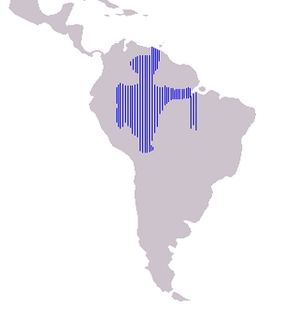
Amazon River Dolphin range
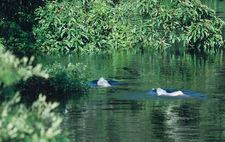
Rivers and lakes in Amazon and Orinoco drainage basins
The place where the Amazon river dolphin lives in is Amazon and Orinoco watersheds, as it shows in the name. Really information technology tin can live in whatever fresh waters except the saline waters, estuaries, strong rapids and waterfalls. [11] Although the dolphin can be observed in other places, it seems like it prefers the deep waters. However, the big changes of water levels influences the popularity of the botos in that region. With the large corporeality of waters by floods or inundation of h2o, the dolphins comes out to the river and enjoys swimming. Confluences, sandbars, and sharp bends are likewise its favorite habitat. During the high flavour, it swims between the copse.
Using the front teeth, information technology catches casualty to eat, and crustaceans, crabs, turtles, and some kinds of fish are nutrient for the dolphin. Information technology eats almost 50 species of fish. Its speed is usually two.4 to five.ane km/h and it tin can be increased likewise. [12]
The dolphins gather in the feeding area and the grouping of the dolphins babely can be seen. The Amazon river dolphins usually do not form the family grouping and flock, only they just swim merely by itself. The closest human relationship in botos is mother and the her kid. Sometimes the dolphins make a group of two or a footling more, but immediately goes abroad from each other, finding another temporary friend. Although it is truthful the pink dolphin is associated with other dolphins, it prefers to be alone and be observed by itself more than oft. [thirteen]
However, Botos are unique animals now that the process to extinct happens to them. The dolphin's distribution along the river has been changed because of pollution, development by humans, and fisheries. [14]
The Amazon River dolphin is protected by the International Union for the Conservation of Nature and Natural Resources (IUCN). There has been lilliputian increase on numbers of boats, but still it need special protection, not being threatened by artificial pollutant. [xv]
Mythology
The Amazon river dolphin has been idea as a sacred animal within the natives of the Amazon. According to the Amazon River myth, it usually changes into the image of human being. Some people insists that, when Boto becomes human, his genitals resemble those of a humans. [16]
One of them states that, at night the Boto transforms to a handsome, young human and fascinates the girls. When he attracts them, it is believed that he takes the girls to entranced underwater globe, called Enkangji. So he comes back to the Amazon river at morning, going back to the dolphin itself again.
Some other myth say that a girl has gotten the beloved from the pink dolphin. There are stories of the daughter who vicious beloved with the dolphin and got pregnant, and the people who were attracted by the botos transformed into the beautiful women on canoes. Also, in some expanse, people believe killing the pinkish dolphin brings bad fortune to them. Moreover, if a person makes center contact with the boto, the nightmare will occur to him since he has seen its eyes. Traditionally, boto has been considered equally a guardian for the Amazon river. [17]
Diverse names
The Amazon river dolphins accept diverse names because of its color or habitat. To make it articulate, IUCN declared the names in the list down.
- Amazon Dolphin
- Boto Vermelho
- Boto Cor-de-Rosa
- Bouto, Inia
- Pink Dolphin
- Wee Quacker
- Pink Freshwater Dolphin
- Pink Porpoise
- Tonina
- Encantado [eighteen]
Therapy
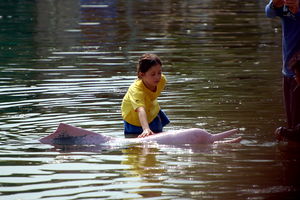
Therapy for children with Pink Dolphin
Dolphins take been a method to treat the people with disabilities. From cancer to psychomotor faults, dolphins are believed and too it has proved that they convalesce the problems and illnesses. [19] For an case, Ms. Deena Hoagland, LCSW, has found improvement on her son, when he was with the dolphin. Her son, Joe had had three open up-center surgery and his body was weak from a stroke, especially on his left side. However, Joe exercised, played and swam with the dolphins. Surprisingly, he got well both physically and psychologically. [20] Deena and her husband believed the dolphins have motivated their son in various ways, and they created Island Dolphin Intendance(IDC). Every bit the dolphins are proved to be beneficial to people with disabilities, therapy with the pink dolphin has been created also. The Pink Dolphin's Therapy Center at the Ariau river was constructed on November 2008. The dolphins emit the ultrasonic waves that piece of work to circulate in human's trunk and give advantages to the nervous arrangement. As well, it is believed that the ultrasound alleviates the problems and figures out the location of problems within the body. The dolphins emit the ultrasound naturally and it helps the cancer patients also. Another benefit from the dolphin therapy is that it motivates person emotionally and produce endorphins that help to better the body functions. [21]
Today, dolphin therapy has been recognized with its effect and comeback. At that place are many places that children can experience the therapy similar in Brazil or Florida. Also, it brings lots of positive outcomes with people's issues.
Threats
The number of Amazon river dolphin has decreased and disappeared by several threats. At present it is protected past the International Matrimony for the Conservation of Nature and Natural Resource (IUCN).
- Habitat destruction
Building dams, hydroelectric improvement, deforestation and other development from human being populations makes difficult environs to the botos. It is much more than challenging for them to survive in the identify where has been their own place. Expanding of human popularity leads mor lands and more than foods to supply and satisfy them. By deforestation, the fish productivity has been brusk of supply, while humans still develops the plain land without thinking of the effects on the ecosystem. Moreover dams forbid migrations and bring artificial environment to not only dolphins only also other aquatic animals. With lower pH levels and fewer fish, the botos live hard to survive.
- Overfishing
Overfishing is another factor of deduction of the dolphins. Fishery is all around the Amazon river and the dolphins are caught besides much thoughtlessly. Not being satisfied with already sufficient amount of grab, people try to catch more and more as possible every bit they can.
- Deliberate killing
Fishermen usually kill the fish on purpose to attract the Amazon river dolphin to grab. More fishermen grab the fish as bait, the less supply of foods the dolphins have.
- Pollution
Pulp mills, and heavy metals pollute the Amazon river and also the environments around the river. Also, air pollution, and water pollution influence the decreasement of the pink dolphins. [22]
Gallery
-
Amazon River Dolphin
(Inia geoffrensis) -
Amazon River Dolphin
(Inia geoffrensis) -
Amazon River Dolphin
(Inia geoffrensis) -
Amazon River Dolphin
(Inia geoffrensis) -
Amazon River Dolphin
(Inia geoffrensis) -
Amazon River Dolphin
(Inia geoffrensis) -
Amazon River Dolphin
(Inia geoffrensis) -
Amazon River Dolphin
(Inia geoffrensis)
References
- Inia geoffrensis CMS.
- Amazon river dolphin Wikipedia.
- Project Boto Project Boto, 2006.
- The pinkish dolphin The nature conservancy.
- Verneable Amazon river dolphin Animal info.
- Boto Redorbit.
- Inia geoffrensis Marinebio.com.
- Pink River Dolphin Anavilhanas, Amazonas, Brazil July 2001.
- Dolphin and their nature Tracy Bishop, Helium.
- Echolocation Dolphin links.
- Dolphin Echolocation Dolphinkind.com, 2010.
- The pinkish dolphin of the rainforest Ulysses Ronquillo, WordPress.com.
- Island Dolphin intendance get-go Island Dolphin Care, 2007.
External link
- Amazon river dolphin Unique southamerica-travel-experience, 2008.
- Amazon river Wikipedia.
- Advent of Amazon river dolphin Telegragh.co.uk, Mar, 2009.
- Pink dolphin Dolphins world.
- Dolphin and more Jennifer'due south dolphin folio.
- Dolphin echolocation Becci Jewell, Cardigan Bay Marine Wild animals Centre, 2005.
- Dolphin facts Dolphinkind.com, 2010.
- Dolphin Therapy program Ricana, Island dolphin care, 2007.
- About dolphins Ricana, Island dolphin care, 2007.
| Biological science | ||
|---|---|---|
| Organisms | Animals • Algae • Amphibians • Bacteria • Birds • Created kinds • Crustaceans • Dinosaurs • Fish • Fungi • Humans • Insects • Mollusks • Plants • Protists • Reptiles |  |
| Disciplines | Agriculture • Anatomy • Baraminology • Biologist • Biotechnology • Phytology • Cell biological science • Ecology • Epidemiology • Embryology • Entomology • Evolutionary biological science • Genetics • Herpetology • Human biology • Medicine • Microscopy • Physiology • Taxonomy • Virology • Zoology | |
| Systems | Auditory system • Circulatory organization • Digestive system • Endocrine arrangement • Allowed arrangement • Integumentary system • Limbic organisation • Lymphatic system • Muscular arrangement • Nervous system • Olfactory organization • Reproductive system • Respiratory system • Sensory system • Skeletal organization • Visual system | |
| Processes | Aging • Prison cell division • Cellular respiration • Diseases • Embryogenesis • Cistron expression • Metabolism • Metamorphosis • Parasitism • Photosynthesis • Pregnancy • Protein synthesis • Reproduction • Symbiosis • Nutrient chain • | |
| | ||
DOWNLOAD HERE
How to Draw a Amazon River Dolphin TUTORIAL
Posted by: danielsonstry.blogspot.com






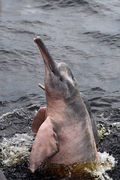
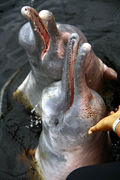


Comments
Post a Comment